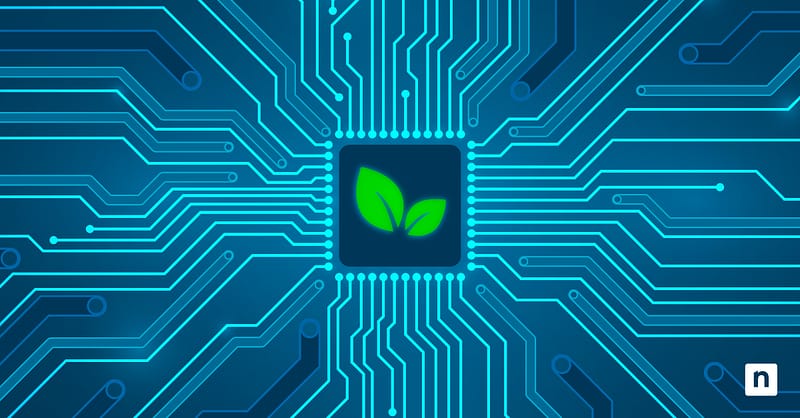Introduction to green IT
Digital operations are an important part of every business’s success, and the environmental footprint of IT practices has surged to the forefront of corporate responsibility discussions. Traditional infrastructure of information technology stands as a significant contributor to global energy consumption, underscoring an urgent call for sustainable measures.
Green IT represents sustainable IT practices and strategic methodologies that use information technology resources in a way that reduces environmental impact. The concept of green IT extends beyond merely cutting energy usage; it encompasses a comprehensive strategy aimed at creating an eco-friendly digital ecosystem. This includes optimizing data center efficiency, embracing energy-efficient hardware and instituting responsible e-waste management policies.
Before you proceed, there’s a video version of this guide — What Is Green IT? Overview & Best Practices, if you’d prefer a visual explanation.
Key principles of green IT
As technology continues to advance, prioritizing sustainability within IT operations has become imperative for modern organizations. Here are the following key principles you should consider:
Reducing energy consumption
A core objective of green IT is to lower the energy usage of information technology operations. This can be done through optimizing software for better energy efficiency. Initiatives such as Google’s use of deep learning to improve the energy efficiency of its data centers showcase how real-world applications can result in significant energy savings.
Minimizing e-waste
Green IT emphasizes the importance of reducing electronic waste by extending the life cycle of IT equipment, promoting recycling and using materials that are easier to recycle. An example is the adoption of modular design in hardware, which allows for easier upgrades and repairs. One instance of this is Fairphone’s modular smartphones, which are designed to allow users to easily upgrade and repair their devices, significantly reducing e-waste by prolonging the life of each unit.
Maximizing economic viability
Making sure green IT initiatives are cost effective is key to their adoption and long-term success. This involves demonstrating that investments in sustainable IT practices lead to cost savings or enhanced revenue in the long run. For example, AT&T implemented energy-efficient practices that not only reduced their carbon footprint but also resulted in substantial cost savings — showing that investments in sustainability can lead to financial benefits.
Ensuring social responsibility
This principle focuses on the idea that you should use technology in a way that benefits society at large, including ethical e-waste management and reducing the digital divide. An example is Dell’s initiative to responsibly recycle or repurpose 100% of its electronic waste and provide technology access and education in underserved communities, which demonstrated a commitment to both environmental and social sustainability.
Benefits of green IT
Embracing green IT practices offers a range of advantages that go beyond environmental conservation. By integrating sustainable IT strategies into your operations, you unlock a variety of benefits that can enhance your business’s performance and reputation. Here’s how green IT can positively impact your organization:
- Cost reduction: By adopting energy-efficient technologies and optimizing resource usage, you can significantly lower your operational costs, from reduced energy bills to savings on hardware expenditures.
- Enhanced brand image: Demonstrating a commitment to sustainability can boost your company’s reputation, making it more attractive to environmentally-conscious customers, investors and partners.
- Regulatory compliance: Green IT practices help ensure that your business stays ahead of environmental regulations and industry standards, reducing the risk of penalties and legal issues.
- Innovation and competitiveness: Implementing sustainable IT solutions can drive innovation within your organization, which can foster new ideas and technologies and give you a competitive edge in the market.
- Employee engagement and retention: A strong commitment to sustainability can improve employee morale and attract talent who value environmental responsibility, leading to higher retention rates and a more motivated workforce.
Best practices for implementing green IT
Implementing green IT involves more than just adopting new technologies. It requires a strategic approach to make sure your initiatives are effective and sustainable. By following best practices, you can successfully integrate green IT into your operations while overcoming common challenges. Below are key strategies to consider:
Optimizing energy usage
Optimizing energy usage is a critical component of green IT. Start by conducting an energy audit to assess your current consumption and identify areas for improvement. Implementing power management settings across all devices, such as servers and workstations, ensures that they enter low-power states when not in use. You can also reduce the number of physical servers by consolidating workloads onto virtual machines, cutting down energy consumption, and simplifying your IT infrastructure.
One challenge you may face is integrating legacy systems into these energy-saving strategies. To address this, consider phasing out outdated equipment and replacing it with more energy-efficient alternatives.
Using energy-efficient hardware
Investing in energy-efficient hardware is another essential practice in green IT. When purchasing new equipment, prioritize devices that are Energy Star-certified or have similar energy-efficient ratings. These products are designed to consume less power without compromising performance.
Additionally, leveraging cloud services can reduce the need for expanding on-premises hardware, as cloud-based solutions typically operate on optimized, shared infrastructure. Implementing lifecycle management by performing regular maintenance and upgrades can also extend the life of your hardware, reducing the environmental impact of frequent new purchases.
Implementing e-waste management programs
Effective e-waste management is crucial for reducing your organization’s environmental footprint. Begin by developing a clear policy that outlines procedures for disposing of electronic waste, including recycling, refurbishing and donating old equipment. Partnering with certified recyclers ensures that your e-waste is handled responsibly and securely.
To further reduce waste, promote a culture of reuse within your organization, encouraging employees to find ways to repurpose or refurbish equipment before considering disposal. Managing e-waste can be complex due to varying regulations across regions, so it’s important to stay informed about local and international e-waste laws and adjust your policies accordingly.
Establishing green procurement policies
Create a green vendor list by identifying and partnering with suppliers committed to sustainable practices. Evaluate vendors based on their environmental policies, such as the use of recycled materials and energy-efficient manufacturing processes.
Incorporate sustainability criteria into your purchasing decisions, requiring products with minimal packaging, recyclable materials, or take-back programs for end-of-life disposal. Since green IT is an evolving field, regularly review and update your procurement policies to reflect the latest best practices.
Educating and training employees
The success of green IT initiatives relies heavily on employee participation. Providing regular training on the importance of green IT and how employees can contribute is essential. These training sessions can cover topics such as energy-saving practices, e-waste management, and sustainable procurement.
The future of green IT
The future of green IT is poised to be transformative, and investing in green computing shows your commitment to sustainability. As organizations continue to recognize the importance of reducing their environmental impact, green IT practices will evolve to encompass even more innovative solutions, such as the integration of artificial intelligence to optimize energy usage and the development of circular economy models to minimize e-waste.
With increasing regulatory pressures and consumer demand for eco-friendly practices, the adoption of green IT is expected to become a standard across industries. Companies that proactively invest in sustainable IT strategies will not only contribute to a healthier planet but also position themselves as leaders in a more conscious and responsible digital economy.
Ready to make your IT operations more sustainable? Revolutionize your approach with NinjaOne’s powerful solutions that help you optimize efficiency and reduce environmental impact. Try it now for free and start building a greener, more efficient IT environment.








